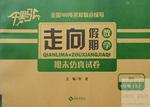题目内容
9. (live) there for some time,Mr Johnson knew the place quite well.
9. Having lived

练习册系列答案
 千里马走向假期期末仿真试卷寒假系列答案
千里马走向假期期末仿真试卷寒假系列答案
相关题目
题目内容
9. (live) there for some time,Mr Johnson knew the place quite well.
9. Having lived

 千里马走向假期期末仿真试卷寒假系列答案
千里马走向假期期末仿真试卷寒假系列答案